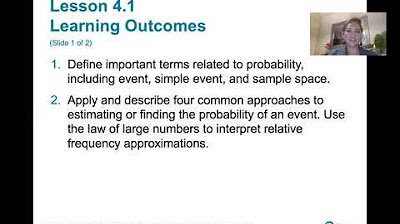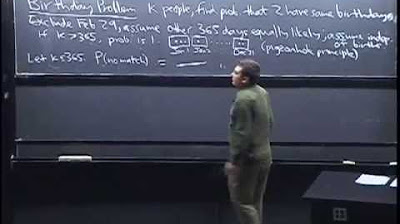4.1.3 Basics of Probability - Finding the probability of the complement of an event
TLDRThis video script explores the concept of the complement of an event in probability theory. It defines the complement as all outcomes where the event does not occur, using the example of rain to illustrate. The script explains how to calculate the probability of the complement by subtracting the event's probability from 1. It also applies this concept to a survey of adult smokers in the U.S., demonstrating how to estimate the probability of selecting a smoker and a non-smoker, reinforcing the idea that the sum of probabilities of an event and its complement equals one.
Takeaways
- 📚 The video discusses the concept of the complement of an event in probability theory.
- 🔍 The complement of an event A, denoted as \( \overline{A} \), includes all outcomes where event A does not occur.
- 🌧️ An example given is that if event A is 'it will rain today,' then \( \overline{A} \) is 'it will not rain today'.
- 📉 The complement of an event is used to find the probability of the event not occurring.
- 🎯 If the probability of event A is known, the probability of \( \overline{A} \) is found by subtracting from 1 (e.g., \( 1 - P(A) \) ).
- 📈 The script explains how to interpret probabilities in terms of percentages and convert them back to decimal form.
- 🌤️ The video uses the example of rain probability to explain how to calculate the complement probability.
- 🚬 Another example involves estimating the probability of selecting a smoker or a non-smoker from a survey.
- 📊 The probability of a randomly selected adult being a smoker is approximated by the ratio of smokers in the survey to the total number of adults.
- 🚭 Similarly, the probability of selecting a non-smoker is found by subtracting the smoker probability from 1.
- 🔁 The concept of complements will be revisited in section 4.2, indicating its importance in the study of probability.
Q & A
What is the complement of an event in probability theory?
-The complement of an event, typically denoted by a bar over the event symbol (e.g., A̅ for the complement of event A), consists of all outcomes in which the event A does not occur.
How can you represent the event that it will not rain today if event A is that it will rain?
-The event that it will not rain today can be represented as A̅ or simply as 'not A'.
What is the relationship between the probabilities of an event and its complement?
-The probabilities of an event A and its complement A̅ must sum up to 1, as they are the only two possible outcomes of a binary situation.
If the probability of rain today is 0.7, what is the probability that it will not rain?
-If the probability of rain (event A) is 0.7, then the probability that it will not rain (event A̅) is 1 - 0.7, which equals 0.3.
How do you interpret a probability of 0.7 in terms of percentage?
-A probability of 0.7 can be interpreted as a 70% chance of the event occurring, by multiplying the decimal by 100.
What is the addition rule in probability theory, and how does it relate to complements?
-The addition rule states that the probability of either event A or its complement A̅ occurring is 1. This is derived from the fact that these are the only two outcomes and their probabilities must sum to 100% or 1.
In the given survey example, what is the estimated probability that a randomly selected adult is a smoker?
-Based on the survey data, the estimated probability that a randomly selected adult is a smoker is 202 out of 1010, which is approximately 0.2 or 20%.
If there is a 20% chance of selecting a smoker from the survey, what is the chance of selecting a non-smoker?
-If there is a 20% chance of selecting a smoker, then there is an 80% chance of selecting a non-smoker, calculated as 1 - 0.2.
What approach is used in the survey example to estimate the probability of an adult being a smoker?
-The relative frequency approach is used, where the probability is approximated by the ratio of smokers in the sample to the total number of adults surveyed.
Why is it important to understand the concept of complements in probability?
-Understanding complements is important as it helps in calculating the probability of the opposite outcome in a binary situation, which is crucial for making informed decisions based on probabilistic outcomes.
How will the concept of complements be revisited in the next section of the study?
-The concept of complements will be revisited in section 4.2, potentially with further examples or a deeper exploration of its applications in probability theory.
Outlines
📚 Understanding Event Complements and Probabilities
This paragraph introduces the concept of the complement of an event in probability theory. It explains that the complement, denoted by a bar over the event symbol, includes all outcomes where the event does not occur. The script uses the example of rain to illustrate this concept, explaining that if the probability of rain (event A) is 0.7, then the probability of no rain (event A') is calculated by subtracting 0.7 from 1, resulting in 0.3. The paragraph emphasizes the additive property of probabilities, where the sum of the probabilities of an event and its complement must equal 1, or 100%. It also provides a practical example involving a survey of 1010 adults, where 202 are smokers, to demonstrate the calculation of the probability of selecting a smoker and a non-smoker based on the sample data.
🚬 Estimating Probabilities with Survey Data
The second paragraph continues the discussion on probabilities, focusing on the application of survey data to estimate the likelihood of an event. It reiterates the calculation of the probability of selecting a smoker (0.2 or 20%) and a non-smoker (0.8 or 80%) from a sample of 1010 adults, where 202 are identified as smokers. The paragraph concludes with a reminder that the concept of complements will be revisited in section 4.2, indicating the importance of understanding these foundational concepts for further study in probability.
Mindmap
Keywords
💡Complement of an event
💡Probability
💡Relative frequency
💡Addition rule
💡Outcome
💡Interpretation
💡Sample
💡Approximation
💡Non-smoker
💡Survey
Highlights
The video discusses learning outcome number three from lesson 4.1, focusing on the concept of the complement of an event in probability.
The complement of an event, denoted by a bar, includes all outcomes where the event does not occur.
Examples are given to illustrate the concept, such as the event of raining and its complement of not raining.
The video explains that the sum of the probabilities of an event and its complement must equal one.
Probability of an event is interpreted as a percentage to understand the likelihood of occurrence.
The probability of the complement is calculated by subtracting the event's probability from 1.
An intuitive understanding is emphasized, where the complement's probability is the remaining chance after the event's probability is accounted for.
The addition rule in probability is mentioned as a formula to be derived later, which will support the understanding of complements.
A survey example is used to estimate the probability of a randomly selected adult being a smoker.
The relative frequency approach is applied to approximate the probability based on survey data.
The probability of a randomly selected adult being a smoker is calculated to be 0.2 or 20%.
The probability of selecting a non-smoker is deduced to be 0.8 or 80% by subtracting the smoker's probability from 1.
The video uses the survey data to approximate the total population's smoking habits.
The concept of complements will be revisited in section 4.2, indicating its importance in the study of probability.
The video concludes with a summary of the key points covered regarding the complement of an event and its probability.
Transcripts
Browse More Related Video

4.2.4 Addition and Multiplication Rules - The Rule of Complementary Events

Probability of Complementary Events & Sample Space

Introduction to Probability, Basic Overview - Sample Space, & Tree Diagrams

Conditional Probability With Venn Diagrams & Contingency Tables

4.1.0 Basics of Probability - Lesson Overview, Key Concepts and Learning Outcomes

Lecture 3: Birthday Problem, Properties of Probability | Statistics 110
5.0 / 5 (0 votes)
Thanks for rating: